9.6 /10 1 Votes9.6
Initial release date March 1991 | 4.8/5 eBay CPU Motorola 68000 (@ 16 MHz) | |||||||||||||||||||||||||||||||||
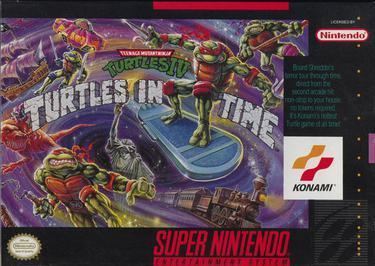 | ||||||||||||||||||||||||||||||||||
Composer(s) Mutsuhiko IzumiKozo Nakamura Genre(s) Side-scrolling beat 'em up Mode(s) Single-playerUp to four player co-op (two player in SNES version) Sound Two channels amplified stereoCPU: Z80 (@ 8 MHz)Chips: YM2151 (@ 3.58 MHz),K053260 (@ 3.58 MHz) Display Raster graphicsHorizontal orientationResolution: 288x224 pixelsRefresh rate: 60.00 Hz2048 colours Similar Teenage Mutant Ninja Turtles games, Konami games, Fighting games | ||||||||||||||||||||||||||||||||||
Teenage mutant ninja turtles turtles in time 4 player netplay arcade game
Teenage Mutant Ninja Turtles: Turtles in Time, released as Teenage Mutant Hero Turtles: Turtles in Time in Europe, is an arcade video game produced by Konami. A sequel to the original Teenage Mutant Ninja Turtles (TMNT) arcade game, it is a scrolling beat 'em up type game based mainly on the 1987 TMNT animated series. Originally an arcade game, Turtles in Time was ported to the Super Nintendo Entertainment System in 1992 under the title Teenage Mutant Ninja Turtles IV: Turtles in Time, continuing the numbering from the earlier Turtles games released on the original NES. That same year, a game that borrowed many elements, Teenage Mutant Ninja Turtles: The Hyperstone Heist was released for the Mega Drive/Genesis.
Contents
- Teenage mutant ninja turtles turtles in time 4 player netplay arcade game
- Gameplay
- Plot
- Development
- Super NES
- Unlockable version in Mutant Nightmare
- Reception
- Remake
- References
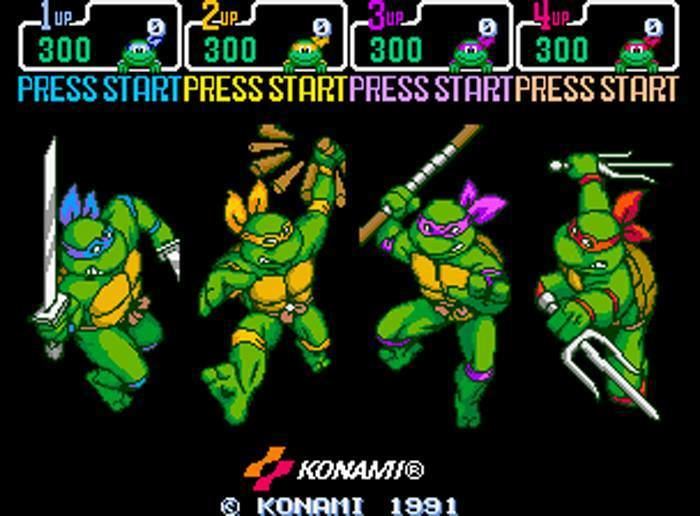
Years later, the arcade version of Turtles in Time was revisited on newer consoles. A slightly altered version of the arcade game was included as an unlockable bonus in the 2005 game Teenage Mutant Ninja Turtles 3: Mutant Nightmare. On 5 August 2009, Ubisoft released a 3D remake of the game, Teenage Mutant Ninja Turtles: Turtles in Time Re-Shelled, available as a download for Xbox 360 via Xbox Live Arcade. A downloadable PlayStation 3 version was later released via PlayStation Network on September 10, 2009.
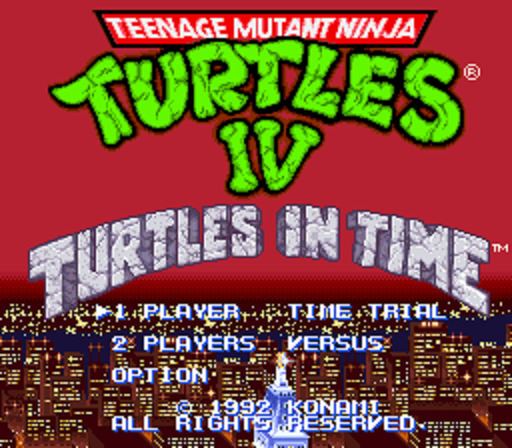
Gameplay
Like its predecessor, Turtles in Time was available for the arcades in two and four-player versions. In the two-player versions, each player gets to choose which of the four turtles they wish to control, whereas in the four-player versions the characters are assigned to the control panel from left to right in the following order: Leonardo, Michelangelo, Donatello, and Raphael. Each playable character has his own strengths and weaknesses. New features in this game include the ability to execute a power attack by hitting an enemy several times in a row, and the ability to slam Foot Soldiers into surrounding enemies.
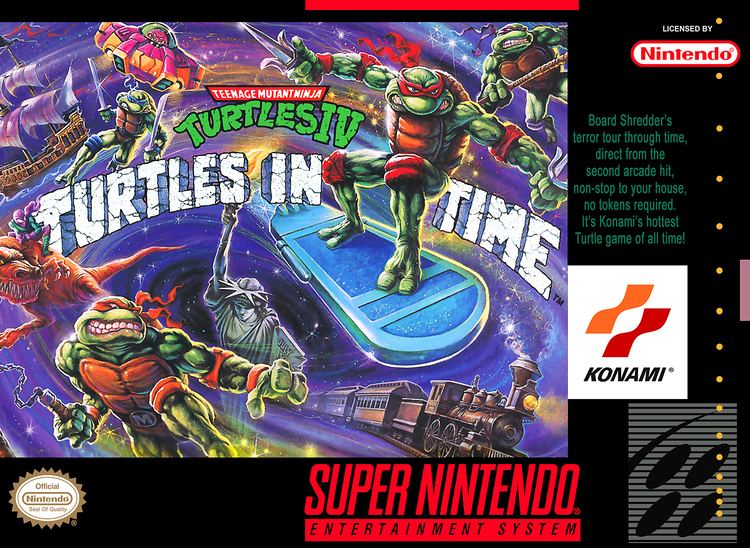
The game features the same control scheme of the previous arcade release. It uses a joystick for movement, an attack button and a jump button. Certain joystick/button combinations can make a Turtle run, perform a slide or dash attack, jump higher, perform a stationary or directed air attack, or perform a special attack.

Players guide the turtles through a series of levels. The first takes place in the streets of New York City. Later levels transport the turtles to representations of various historical eras. In each level, players face enemies from both the 1987 cartoon and the feature film Teenage Mutant Ninja Turtles II: The Secret of the Ooze, including Foot Soldier and Stone Warriors. Bosses include the fly form of Baxter Stockman, Metalhead, Tokka and Rahzar and Leatherhead.
Plot
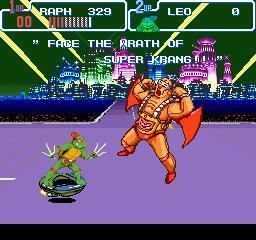
The introductory cut scene of the game details the game's plot. It begins with the Turtles watching a TV newscast on a Sunday evening, with April O'Neil reporting from Liberty Island. Suddenly, Krang flies in using a giant exosuit (seen occasionally in the animated series) and steals the Statue of Liberty, moments before Shredder hijacks the airwaves to laugh at the Turtles.
The Turtles jump into action in downtown New York and pursue the Foot to the streets and the city sewers (then to the Technodrome in the SNES version), where Shredder sends them through a time warp. The Turtles must fight Shredder's army in both the past and the future in order to get home. They face Shredder until he falls to his death and the Statue of the Liberty is returned to its place.
Development
The original music of the game's soundtrack was composed by Mutsuhiko Izumi, a TMNT veteran who also composed the music for the previous arcade game in the series. It was arranged for the Super NES version by Kazuhiko Uehara and Harumi Ueko, both of whom went on to produce several Konami games, including the following TMNT game, Tournament Fighters.
In addition to an original musical score, the attract mode of the arcade game is noted for featuring the song "Pizza Power", which was taken from the TMNT live concert, known as the Coming Out of Their Shells Tour. The game's music was released as part of the compilation album Konami All-Stars 1993 ~ Music Station of Dreams, published by King Records in 1992.
The 2005 version of the game included in Mutant Nightmare features new music and voices updated to match the 2003 TMNT series. This was also the case for Turtles In Time: Re-Shelled.
Super NES
The Super NES version was retitled Teenage Mutant Ninja Turtles IV: Turtles in Time in North America and Australia and Teenage Mutant Hero Turtles IV: Turtles in Time in Europe in order to continue the numbering from the first three Turtles games on the NES (despite the fact that Teenage Mutant Ninja Turtles III: The Manhattan Project was never released in the PAL region). However, the Super Famicom version in Japan retained the original unnumbered title.
Much like Teenage Mutant Ninja Turtles II: The Arcade Game for the NES (a conversion of the first arcade game), the SNES version of Turtles in Time is not a direct port of the arcade original. It had some notable differences in presentation. While the SNES version is missing some animations and graphics effects from the arcade version, it made extensive use of the SNES's Mode 7 forward scrolling effect in the "Neon Night-Riders" level. It also featured the option to give each turtle a unique skin tone. Most memorably, the throw move involved Foot Soldiers being thrown directly at, and hitting, the screen. The first fight with Shredder in the Technodrome level was added and requires the player to hit a foreground Shredder with the throw move.
Sounds also differ between the arcade and SNES versions. The SNES version is missing certain voice samples for both the turtles and boss characters. In addition, the arcade version's title theme song, "Pizza Power", was replaced with an instrumental version of the cartoon theme song.
Various alterations were made to the SNES version's gameplay. While the original arcade game was set in the year 1991, the SNES version opens in 1992. "Sewer Surfin'" and "Neon Night-Riders" were changed to bonus levels and a new Technodrome stage was added.
Several enemies were changed in the SNES version. Five new bosses were added: Slash (who replaced Cement Man), the Rat King, Battletank Shredder, and the duo of Bebop and Rocksteady (who replaced Tokka and Rahzar, who were moved to the new Technodrome level). The game also replaces the final boss with Super Shredder from Teenage Mutant Ninja Turtles II: The Secret of the Ooze (who previously appeared in Manhattan Project for the NES). The SNES version also adds two regular enemies: Roadkill Rodneys (which replaced the boxing robots) and Mousers.
The SNES version also features a time-trial mode and a two-player versus fight mode. Like the arcade version, each turtle was given unique attributes in areas such as speed and strength. In addition, the move to throw enemies off-screen can now be performed intentionally (instead of just randomly), a technique specifically required at the end of the Technodrome level.
Unlockable version in Mutant Nightmare
An emulated conversion of the original arcade game can be unlocked after completing the first batch of missions in Teenage Mutant Ninja Turtles 3: Mutant Nightmare. The game is emulated from the four-player version. Differences include the lack of a score counter, an entirely new soundtrack (likely due to rights issues with the original soundtrack), altered voices, and a slightly choppy frame rate compared to the arcade. Much like the version it was based on, the characters are assigned by controller. This means that Donatello and Raphael are not playable in the PlayStation 2 version without a multitap, as the base console only has two controller slots. The new soundtrack is a re-arranged version from the Nintendo DS version of Mutant Nightmare.
Reception
Following its release, Turtles in Time became Konami's best selling arcade title. Although critics found that the second game was largely similar to the previous arcade game, they felt that it was a net improvement over its predecessor on all points, including graphics, music and gameplay. Overall, the game was hailed for staying true to its source material.
The SNES version was praised for its additional stages and gameplay modes. Like the arcade version, the SNES game has been lauded for its visuals, which replicate the cartoon's art style. The game's music and sound effects have also been praised. However, the game has been criticized for its repetitive gameplay and short length. Despite these criticisms, Nintendojo called Teenage Mutant Ninja Turtles IV: Turtles in Time the best Ninja Turtles game of all time, while ScrewAttack called it the best Beat Em' Up ever.
Remake
The 2009 remake, Teenage Mutant Ninja Turtles: Turtles in Time Re-Shelled, features new graphics and sounds. The graphics were remade completely in 3D, with players now moving in and out of a true 3D camera. The opening and closing cinematics were remade with a stylized 2D look. The vocal quips of the arcade version return, re-recorded by the cast of the 2003 cartoon. The music was also re-done for every stage.
Re-Shelled was based on the original arcade machine, rather than on the SNES version. As a result, the extra stages and enemy characters from the earlier home version were excluded. The gameplay remained similar, except that players could now attack in eight directions. The game could also be played online with up to four players. This version also features a Survival mode, Quickplay mode, multiple difficulties and Achievements/Trophy support.
